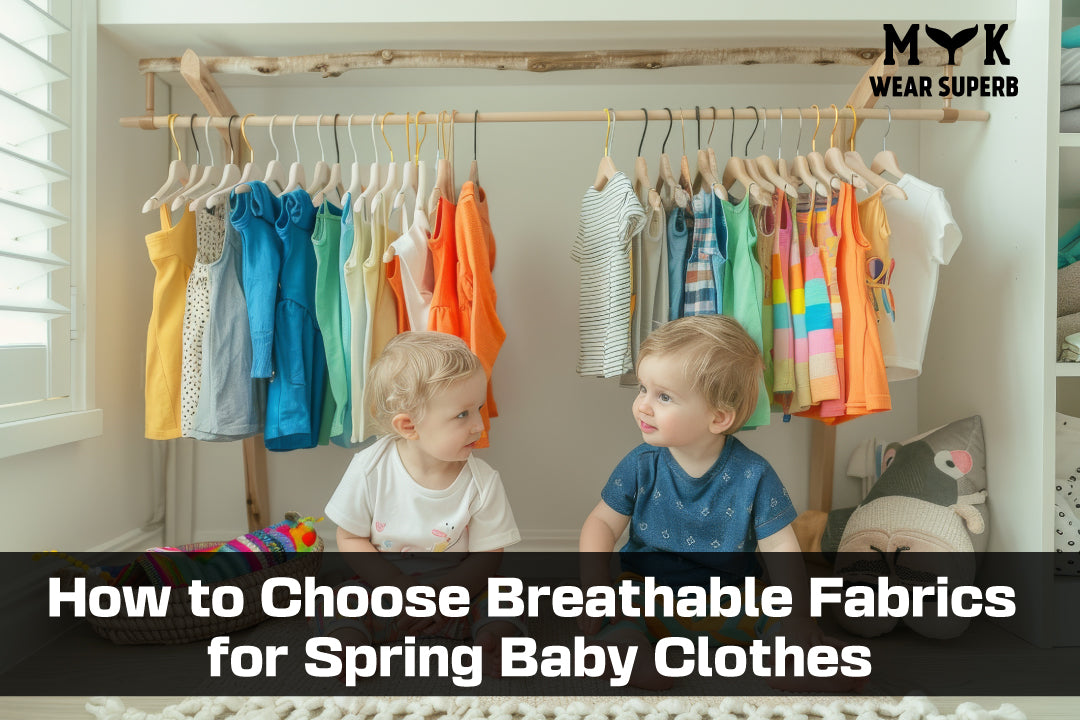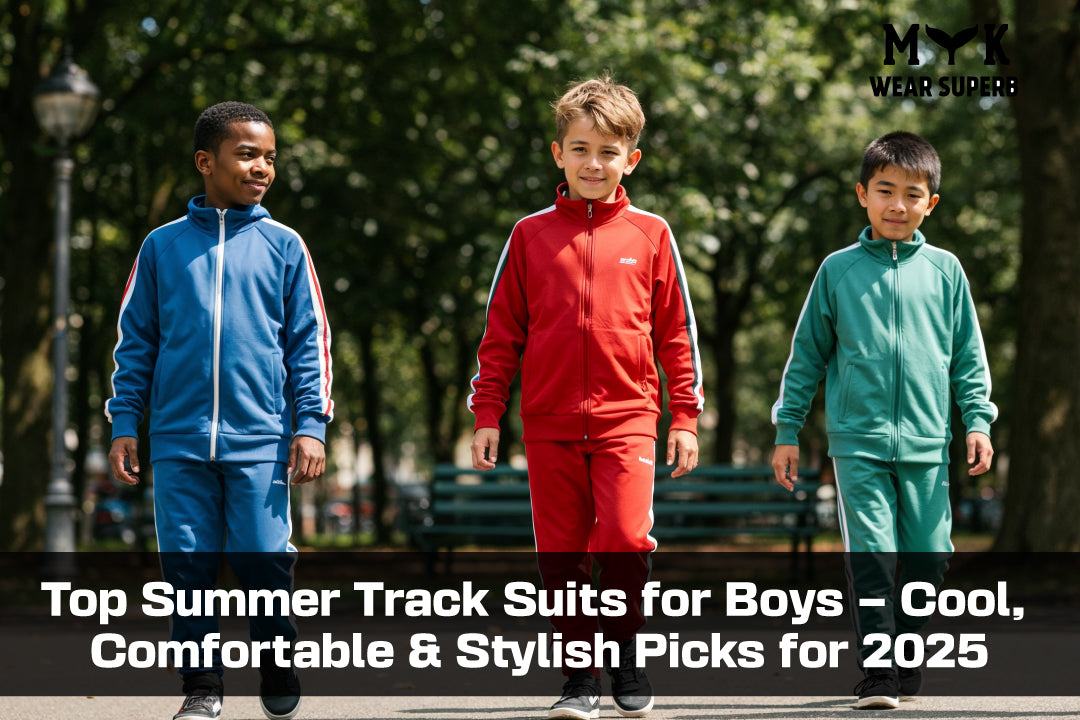
How to Choose Breathable Fabrics for Spring Baby Clothes
Share
Spring is a season of delightful transitions – cool mornings give way to warm afternoons, and sunny spells can quickly turn to breezy gusts. For babies, whose delicate thermoregulation systems are still developing, choosing the right clothing is paramount. baby fashion trends for spring the absolute cornerstone of a comfortable spring wardrobe, preventing overheating, minimizing fussiness, and protecting their sensitive skin.
When selecting baby fashion trends for spring the focus should shift away from heavy, insulating materials to those that promote airflow, wick away moisture, and feel gentle against their skin.
Why Breathability Matters for Babies in Spring
- Preventing Overheating: Babies have a larger surface area to mass ratio than adults and can overheat quickly, especially when dressed in non-breathable fabrics. Breathable materials allow excess heat to escape, regulating their body temperature.
- Moisture Management: As temperatures rise, babies can sweat. Breathable fabrics help wick moisture away from the skin, preventing dampness, chafing, and the development of heat rash.
- Skin Health: Delicate baby skin is prone to irritation. Natural, breathable fibers are generally softer, less likely to cause allergic reactions, and allow the skin to "breathe," reducing the risk of eczema flare-ups and other skin conditions.
- Comfort and Fussiness: An overheated or clammy baby is a fussy baby. Comfortable clothing directly contributes to a happier, more settled infant.
- Adaptability to Changing Temperatures: Spring weather can be unpredictable. Breathable fabrics make layering easier and more effective, as they prevent overheating even when an extra layer is added or the sun comes out unexpectedly.
Key Characteristics of Breathable Fabrics:
When you're scrutinizing fabric labels, look for these inherent qualities:
- Porous Weave: The fabric should have tiny spaces between its threads, allowing air to pass through freely.
- Moisture-Wicking Properties: The ability to draw moisture (sweat) away from the skin to the fabric's outer surface, where it can evaporate.
- Soft Hand Feel: Gentle on sensitive skin, preventing irritation.
- Lightweight: Avoid heavy, dense materials that trap heat.
Top Breathable Fabrics for Spring Baby Clothes:
Here are the best choices for your little one's spring wardrobe, along with their specific benefits:
-
Cotton (Especially Organic Cotton):
- Pros: The undisputed king of baby fabrics. Cotton is exceptionally soft, highly breathable, absorbent, and durable. It allows air to circulate freely and feels comfortable against the skin. Organic cotton is even better, as it's grown without harmful pesticides, reducing the risk of skin irritation and environmental impact.
- Ideal for: Everyday bodysuits, onesies, sleepers, t-shirts, light pants, and dresses. It's versatile enough for both cool and warm spring days.
- Consider: Look for jersey knit cotton for stretch and softness, or interlock knit for a slightly thicker, more durable feel.
-
Bamboo Rayon/Viscose:
- Pros: An increasingly popular choice for baby clothes due to its incredible softness (often compared to silk or cashmere), excellent breathability, and superior moisture-wicking properties. Bamboo fabric naturally helps regulate temperature, keeping babies cool in warmth and warm in coolness. It's also often hypoallergenic.
- Ideal for: Sleepers, bodysuits, soft play clothes, and anything directly touching the skin where supreme comfort is desired.
- Consider: Check for certifications to ensure sustainable processing, as the conversion of bamboo into rayon can sometimes be chemically intensive.
-
Linen:
- Pros: Derived from the flax plant, linen is known for its exceptional breathability and absorbency. It has a slightly crisp, textured feel that gets softer with every wash. Linen naturally wicks away moisture and has a loose weave that allows maximum airflow, preventing clinging.
- Ideal for: Overalls, shorts, dresses, and more structured but still breathable outfits for warmer spring days or special occasions.
- Consider: It wrinkles easily, which is part of its charm, but something to note if you prefer a perfectly smooth look.
-
Muslin:
- Pros: A loosely woven, plain-weave cotton fabric. It's incredibly lightweight, soft, and highly breathable, making it perfect for warmer spring days. Its open weave allows excellent air circulation, and it becomes softer with each wash. Often used for swaddles, but also for clothing.
- Ideal for: Lightweight rompers, shortalls, and breathable sleep sacks.
- Consider: Can be delicate due to its loose weave, so gentle washing is recommended.
-
French Terry:
- Pros: A knit fabric with loops on one side and soft piles on the other, typically made from cotton or a cotton blend. It's more substantial than a t-shirt fabric but lighter than fleece, offering warmth without bulk. Its breathability and moisture-wicking properties make it excellent for active babies during transitional spring weather.
- Ideal for: Tracksuits, comfortable pants, hoodies, and sweatshirts for cooler spring mornings or evenings.
- Consider: Ensure the weight is appropriate for spring, avoiding very thick variations.
Fabrics to Use with Caution or Avoid for Spring:
- Heavy Fleece/Polyester: While cozy for winter, thick fleece or 100% polyester can trap heat and moisture against the skin, leading to overheating and sweat rash in spring.
- Wool (Heavyweight): While breathable in its own way (especially merino wool), heavy wool can be too warm and itchy for spring and might cause overheating unless it's a very thin, fine merino base layer for cooler days.
- Nylon/Synthetic Blends : Many synthetic fabrics can be non-breathable and cause sweating if not specifically designed with moisture-wicking properties.
Practical Tips for Spring Baby Dressing:
- Layering is Key: Embrace the art of layering! Start with a breathable cotton or bamboo bodysuit as a base. Add a lightweight cotton long-sleeve top or romper, and a cardigan or light jacket for cooler parts of the day. You can easily remove layers as the temperature rises.
- Check the Back of Their Neck: This is the best indicator of your baby's temperature. If it's sweaty, they're too warm. If it's cool, they might need an extra layer.
- Consider Sun Protection: Even on cool spring days, UV rays can be strong. Opt for clothes with longer sleeves and legs made from breathable fabrics, or look for UPF-rated clothing for outdoor play.
- Always Have a Spare: Spring puddles, unexpected breezes, and baby messes mean always having an extra change of breathable clothes on hand.
By prioritizing breathable fabrics like cotton, bamboo, linen, and muslin, you can ensure your little one stays comfortable, dry, and happy throughout the delightful and sometimes unpredictable weather of spring.
- AdorableStyle
- affordable baby clothing brands in Pakistan
- Affordable Kids Winter Clothes
- all-season kids jackets
- Baby care
- baby carriers
- Baby clothes buying guide
- Baby clothes made from soft fabric
- baby clothes t
- baby clothing
- Baby clothing checklist
- Baby clothing essentials
- Baby fashion brand
- baby gear
- Baby lifestyle
- Baby Nikar
- baby outfits
- baby outfitsbaby clothing
- Baby wardrobe essentials
- Baby wear for newborns
- baby winter sweatshirts Pakistan
- BabyBoyClothes
- BabyClothing
- BabyFashion
- BabySharkTracksuit
- Best baby clothing brand for comfort
- Best baby clothing essentials
- Best baby outfit brand
- best deals on baby sweatshirts online
- best denim jackets for kids
- Best Winter Clothes for Kids
- Best winter wear for children
- Big Winter Savings
- CasualWear
- children denim jackets
- children fashion
- Children Winter Clothes
- Children Winter Collection
- Children Winter Wear
- Children's Winter Wear
- ChoosingTheRightFit
- Clothing Discounts
- clothing guide
- clothing materials
- Clothing Size Chart
- comfortable baby clothes
- Comfortable winter wear for kids
- ComfortableKids
- ComfortableStyle
- CuteKidsOutfits
- denim jackets for kids
- DisneyStyle
- easy care kids clothing
- End-of-Year Clothing Sales
- Everyday Winter Wear for Kids
- FashionAdvice
- FashionBrand
- FitnessFashion
- fleece jackets for kids
- GirlsWardrobe
- HelloKittyOutfits
- HelloKittyTrousers
- How to choose winter wear for children
- Infant clothing essentials
- Kids Clothing
- Kids Clothing Stores
- kids denim jackets
- kids fashion jackets
- Kids Fashion Sales
- kids fleece jackets
- kids jackets online
- kids stylish outfits
- Kids Warm Winter Clothing
- Kids Winter Clothing
- kids winter clothing Pakistan
- Kids winter jackets
- kids winter wear
- Kids Winter Wear Online Pakistan
- Kids Winter Wear Pakistan
- Kids Winter Wear Sale
- Kids' Clothing
- Kids' Style
- KidsClothing
- KidsFashion
- lightweight jackets for kids
- little girl
- MaximizeYourExperience
- Mega Winter Sale
- MickeyMouseLove
- MickeyMouseTee
- MYK Kids Clothing
- MYK Kids Winter Clothing
- MYK Kids Winter Wear
- MYK Wear Superb
- MYK Wear Superb baby sweatshirts
- MYK Wear Superb Pakistan
- MYKClothing
- MYKOnline
- NavigateMYK
- Online Shopping for Kids
- OnlineLearning
- ParentingTips
- safe baby clothing
- sequence shirt
- ShopMYK
- Shopping Guide
- Shopping Tips
- Size Guide
- SonicInspired
- SonicSweat
- SonicTheHedgehog
- StepByStepGuide
- StyleYourWay
- styling sequence shirts
- stylish baby products
- StylishBabies
- StylishKid
- Sustainable Kids Fashion
- swaddles
- Top baby wear brand
- TrackSuitForKids
- TrendyOutfits
- Winter clothes for kids
- Winter Clothing for Kids
- Winter Fashion for Kids
- winter jackets for kids
- Winter outfits for children


